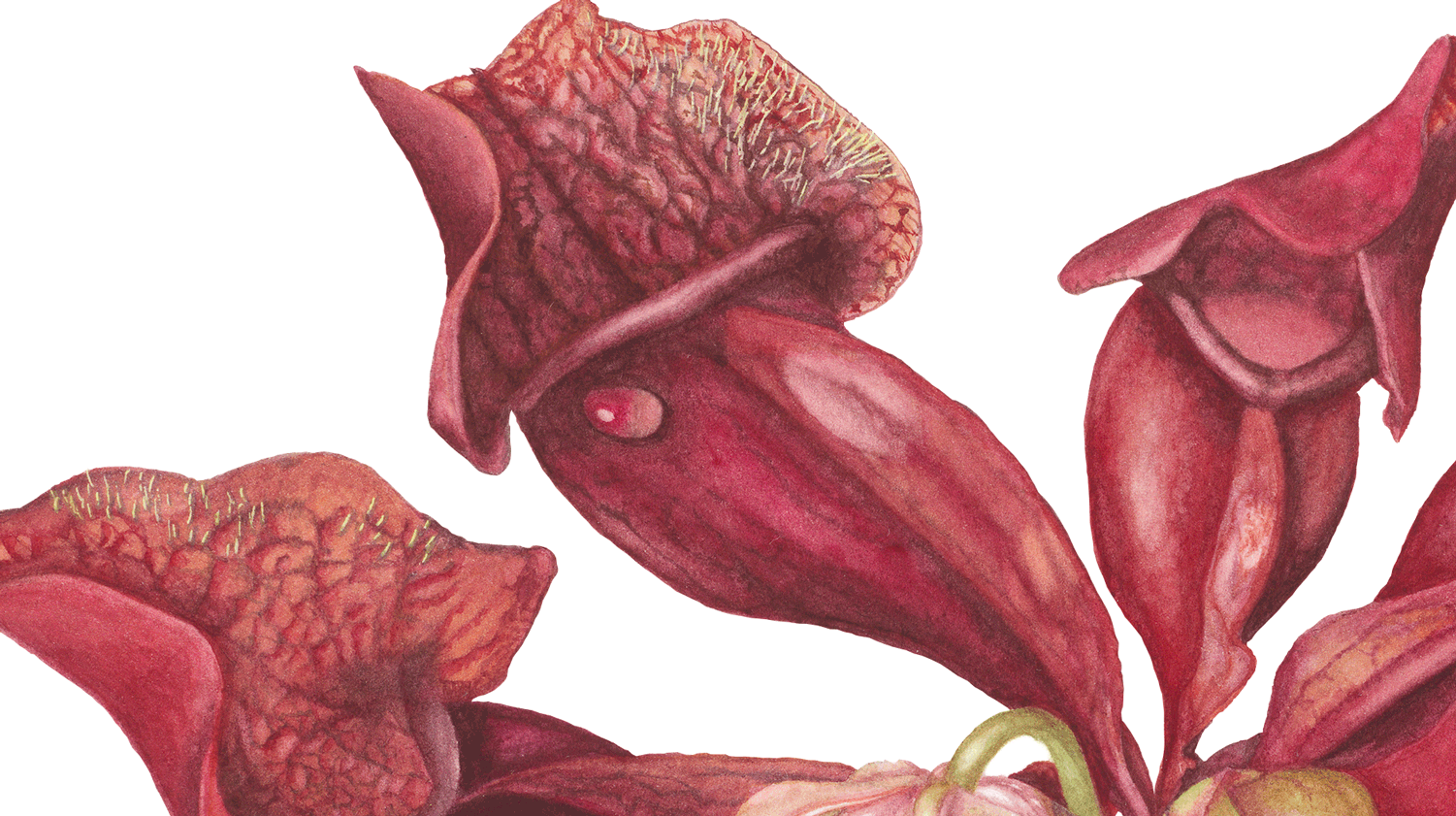I was working at a pharmaceutical company for the longest time, saving lives and making a happy living for myself… Well, until I met “carnivorous plants” at the Boston Flower Show. They were weird, wild and wonderful! They come in different shapes and colors. Venus flytraps, pitcher plants, sundews, bladderworts, and corkscrew plants. Each has developed a unique way of attracting, capturing, and digesting insects. I was completely awed by their singularity and beauty. After joining the New England Carnivorous Plant Society who displayed the carnivorous plants at the Boston Flower Show, the size of my collection increased exponentially. The more I learned about them, the more I got pulled into the sinister and mysterious world of carnivorous plants. Next thing you know, I quit my job, and started painting botanical art as one of ways to express my passion for carnivorous plants. As I studied each plant more carefully with the accuracy required for botanical art, my curiosity about these plants became inexorable. I now study carnivorous plants in a graduate program, working on my PhD. For better or worse, my obsession with carnivorous plants has changed my life!
A few tales about carnivorous plants…

One evening, I found this plant, Sarracenia rosea, glowing like a fire in the setting sunlight. I painted it to keep this vivid image permanent. Sarracenia rosea is a North American pitcher plant, and is carnivorous. They secrete sweet and fragrant nectar on the lid and around the rim of the trap. The insects come to drink the nectar,slip into the trap, won’t be able to get out because numerous hairs on the lid grow downward towards the trap. The insects that fall for this plant’s ruse are finally digested within, giving the plant the nutrients it needs. This plant is one of my favorite plants from my collections.
P. ramosa (aka Koshinso) is a butterwort, a type of carnivorous plants that grows in Nikko mountains in Japan. There are only 5 native sites that are known to date. This species, for some unknown reasons, is extremely difficult to grow in cultivation. For these reasons, it is critically endangered, and any records of accurate scientific descriptions and drawings are of dire importance. A few years ago, I had a privilege to visit one of the native sites, and was able to paint them.
 (1) describes a cluster of blooming P. ramosa (2x). Most people immediately react that the orientation is wrong, but actually, this species, like most Pinguicula, grows on the walls of vertical gorges and cliffs between 1500 to 2000 m in elevation , and sends out inflorescence horizontally to the ground. Interestingly, when the seeds are set (2, 4x), the inflorescence stretches backwards towards the surface of the gorge wall and embed the seed pods in the medium (3). Another unique feature of this plant is that a single flower stalk holds up to 4 flowers (4, 2x). Other Pinguicula species only hold one flower per stalk. (5) shows a magnification (4x) of traps. Note the numerous sticky glands covering the surface of the trap leaves and stems, which help it capture any insect that falls for this plants trickery.
(1) describes a cluster of blooming P. ramosa (2x). Most people immediately react that the orientation is wrong, but actually, this species, like most Pinguicula, grows on the walls of vertical gorges and cliffs between 1500 to 2000 m in elevation , and sends out inflorescence horizontally to the ground. Interestingly, when the seeds are set (2, 4x), the inflorescence stretches backwards towards the surface of the gorge wall and embed the seed pods in the medium (3). Another unique feature of this plant is that a single flower stalk holds up to 4 flowers (4, 2x). Other Pinguicula species only hold one flower per stalk. (5) shows a magnification (4x) of traps. Note the numerous sticky glands covering the surface of the trap leaves and stems, which help it capture any insect that falls for this plants trickery.
Utricularia, aka bladderwort, is a small and inconspicuous plant that bears dainty flowers. Despite its innocent look, it is a carnivorous plant. The traps are shaped like bladders, and are usually hidden beneath the earth. The bladder is negatively pressured when it is set. When a prey brushes against the trigger hairs on the trap door, the door flings open and the prey is vacuumed up into the trap. Utricularia resupinata is native to New England, and grow in sandy banks of oligotrophic kettle ponds. I like to visit and draw them when they are blooming profusely in late summer to fall. The flower looks almost like a dancing girl in a pink tutu.
Emmi Kurosawa first published this post at Plant Love Stories.






